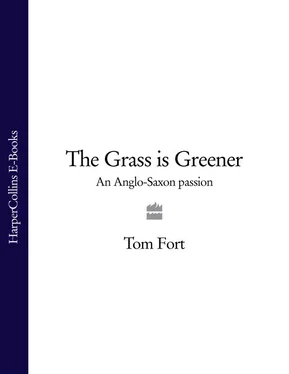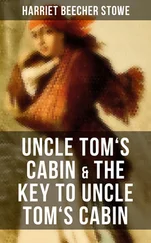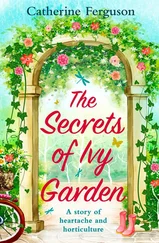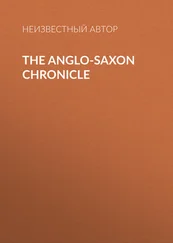Although it is convenient and gratifying to refer to these assorted patches of green as lawns, it is anachronistic and a touch misleading. The Latin word used by Bartholomew is pratum , which is translated in English as ‘mead’, from the Old English medwe . The word ‘lawn’ is derived from the Old French laund , and was not known in the Middle Ages at all. According to the Oxford English Dictionary , it made its debut in Thomas Elyot’s dictionary of 1548 – ‘a place voyde of trees, as in a parke or forret’. It retained this meaning, of an open space between trees, in Johnson’s dictionary of 1755, illustrated with lines from Paradise Lost :
Betwixt them lawns, or level downs, and flocks
Grazing the tender herb were interposed.
Actually, had the great lexicographer inquired a little more assiduously, he would have found that the word had already been particularized to a degree, being applied to an expanse of grass laid down by design in the vicinity of a house, with the purpose of enhancing its appearance. But, although there are examples of the word being used in that sense quite early in the 18th century – for instance in Miller’s Garden Kalendar of 1733 – the application was far from universal. Indeed, as late as 1833, in The English Gardener , Cobbett refers to such features as ‘grass-plats’. Go back to Johnson, and you find these as ‘grass-plots’, defined as ‘a small level covered with short grass’, and illustrated with a line from Shakeapeare’s Tempest – ‘here on this grass-plot, in this very place, come and sport’.
If we then return to Bartholomew, we find him warbling about his meads ‘y-hight with herb and grass and flowers of diverse kind. And therefore, for fairness and green springing that is within, it is y-said that meads laugheth.’ This, then, is the medieval lawn, not notably kempt, the grass sparkling with daisies, violets, trefoil, speedwell. And having made the leap from the monastery, the concept of grass as something more than a source of food for sheep and cattle took hold in the developing English artistic consciousness. In Chaucer’s Legend of Good Women , the good women disported themselves
Upon the small, soft, sweet grass,
that was with flowers sweet embroidered all
of such sweetness and such odour all.
A few years later the unknown author of The Floure and the Leafe carolled in anaemic Chaucerian imitation of a herber
that benched was, and with turves new
freshly turved, whereof the grene gras
so small, so thik, so short, so fresh of hew
that most lyk to grene wol, wot I, it was.
This earthly paradise corresponds with that encountered by the travellers in Boccaccio’s Decameron in the gardens of the Villa Palmieri near Florence – ‘a meadow plot of green grass, powdered with a thousand flowers, set round with orange and cedar trees’.
The historian is properly grateful for these fragments. But, in the absence of any surviving medieval English garden, any detailed description of one, or any comprehensive work of instruction from which to make sound deductions, it is tempting to make much – perhaps too much – of the inherently unreliable evidence presented by poets and painters. This is not to suggest that Chaucer and lesser mortals were engaged in deliberate deceit. But, in general, the purpose of art and literature was not to record the world as it was, but to present a brighter, more beautiful, divinely inspired vision; the world as it might be if God’s creatures abandoned their vicious ways and lived according to his Word (the Canterbury Tales being, in part, the glorious exception).
It is difficult to believe that anyone who read the most popular European poem of the 14th century, Guillaume de Lorus’s Roman de la Rose , can have related the interminable amorous gyrations of its courtly hero to anything happening in their own lives. This was the century of the Black Death, the Peasants’ Revolt, the Hundred Years’ War. Life was assaulted by the prospect of death by violence or putrefying disease, privation, starvation or social upheaval; and it was understandable that the artistic consciousness should have preferred to dwell in a clean, sweet-smelling, idealized kingdom of the imagination.
This is the setting for the Roman de la Rose , which Chaucer translated from the French. Here, freed from any obligation to engage with life, the courtier could devote himself to the intricacies of love-making, his delicate footsteps directed by the bloodless conventions of courtly love. He progresses, at the speed of a snail, towards his fulfilment, enacted in the centre of a garden in the form of a perfect square, with a fountain at the intersection of its diagonals. The sky is blue, the air warm, the cheeks of the participants untouched by mark of pox, their clothes neat and clean, the birds a-twitter, the trees in blossom, the grass lush and spangled with violets and periwinkles and flowers red and yellow – ‘such plenty there grew never in mead’, Chaucer writes. In the 15th-century illustrations of the poem in the British Museum, we see the courtly company loose in this Eden, prancing around to the strains of harp, oboe and fife-and-drums, beneath their feet a soft carpet of vegetation, their milk-white faces shaded by luxuriant trees.
It is a world of complete make-believe, purged of ugliness. We meet it in Stefan Lockner’s Madonna in the Rose Arbour , in which the grass is studded with daisies, violets, red clover and strawberries; in the Hennesy Book of Hours , where the saints Cosmos and Damian are seated on a turf bench in the middle of a lawn bright with daisies and camomile; in a fresco of Pinturicchio showing Susannah and the Elders against a background of turf and flowers; in the tapestry known as the Lady with the Unicorn , where the lady receives a jewelled necklace from her maid, standing in a flowery mead.
I encountered it on my honeymoon, in the chapel built in Granada to contain the remains of the Catholic monarchs, Ferdinand and Isabella. It was a Flemish painting of the early 15th century, displaying a fine palace, a garden in which squares of grass are divided by gravel paths, a low wall with peacocks on it, a couple reading under a tree, a knot with spindly trees, a lake with a swan and sloping lawns leading down to it, the grass shorn rather than shaggy.
So medieval man, or our time parachutist, would have found lawns in the imaginary world of poetry, painting and tapestry; and might have encountered a version of the real thing within the great ecclesiastical institutions, and adorning royal pleasure grounds. But to believe a stroll around the countryside would have brought him, sooner or later, to a well-ordered garden containing cultivated grass is probably fanciful. Miles Hadfield, in his History of British Gardening , asserts that gardening as an aesthetic pursuit did not exist in England before the end of the 15th century. He dismisses attempts to cite the walled and trellised gardens of the Roman de la Rose illustrations, arguing that the presence of such exotics as dates, liquorice and zedoary reflects a purely Continental tradition. Energetic medievalists necessarily disagree, maintaining that, with the development of international commerce, Continental influences must have achieved a degree of penetration; and that, anyway, the division between serviceable and aesthetic is false.
To put this argument simplistically, medieval man would have grown his apples and pears to eat or sell them, his leeks and garlic to make soup, his thyme and hyssop and sage to flavour his food and treat his ailments, his vines to make wine. And in the planting and the growing and the harvesting, he would have taken a spiritual pleasure; smiled at the blossom, breathed in the fragrance, felt the fatness of grapes in his hand; and, consciously or unconsciously, he would have found that there was a correlation between the arrangement of his garden and the degree of his pleasure.
Читать дальше












